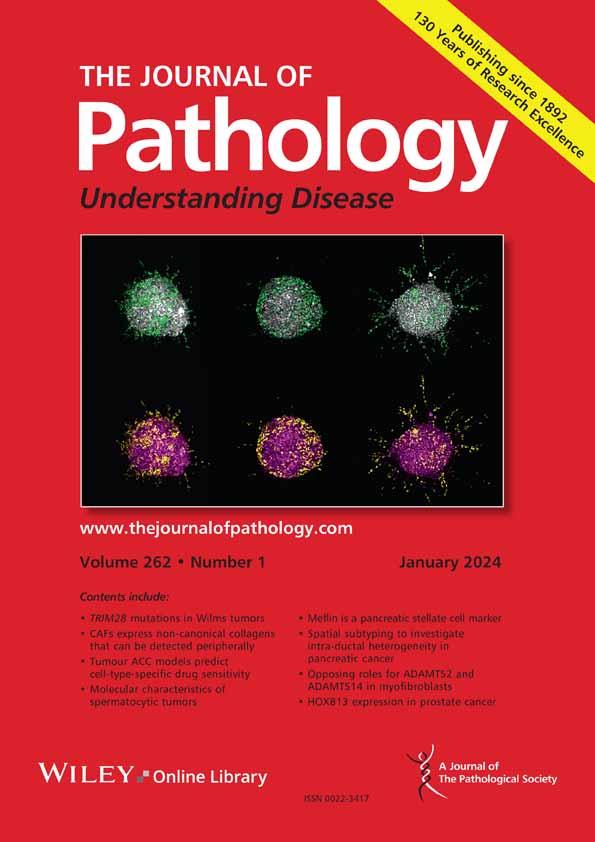下载PDF
{"title":"TERT表达异常:慢性炎症与肝细胞癌之间的联系","authors":"Rui Dong, Gregoire Najjar, Cagatay Günes, André Lechel","doi":"10.1002/path.6421","DOIUrl":null,"url":null,"abstract":"<p>Telomerase reverse transcriptase (TERT), the catalytic enzyme component of telomerase, plays multiple roles in cellular biology. Its canonical function is primarily associated with telomere maintenance and genomic stability. In addition, several studies revealed critical non-canonical extra-telomeric functions of TERT in various cellular processes, including cell proliferation and survival, DNA damage response, transcription, signal transduction, and metabolic regulation, both in normal and in cancer cells. Notably, TERT is aberrantly upregulated in more than 80% of hepatocellular carcinoma (HCC) cases, making it an important target in liver cancer research. However, due to the diversity and complexity of TERT's functions <i>in vivo</i>, the precise mechanisms by which TERT contributes to the initiation and progression of HCC remain unclear. A recent study published in <i>The Journal of Pathology</i> using the <i>Alb-Cre;Tert</i>Tg mouse model and clinical HCC samples addresses the role of TERT in hepatocarcinogenesis. The study demonstrates that TERT promotes cell cycle progression and hepatocarcinogenesis by enhancing NF-κB promoter activity and facilitating the ubiquitination of p21. Notably, absence of functional p53 accelerates liver tumor development in TERT transgenic mice. These findings further underscore the critical role of TERT in inflammation-driven hepatocarcinogenesis and provide new insights into its underlying mechanisms. © 2025 The Author(s). <i>The Journal of Pathology</i> published by John Wiley & Sons Ltd on behalf of The Pathological Society of Great Britain and Ireland.</p>","PeriodicalId":232,"journal":{"name":"The Journal of Pathology","volume":"266 2","pages":"130-133"},"PeriodicalIF":5.2000,"publicationDate":"2025-04-11","publicationTypes":"Journal Article","fieldsOfStudy":null,"isOpenAccess":false,"openAccessPdf":"https://onlinelibrary.wiley.com/doi/epdf/10.1002/path.6421","citationCount":"0","resultStr":"{\"title\":\"Aberrant TERT expression: linking chronic inflammation to hepatocellular carcinoma†\",\"authors\":\"Rui Dong, Gregoire Najjar, Cagatay Günes, André Lechel\",\"doi\":\"10.1002/path.6421\",\"DOIUrl\":null,\"url\":null,\"abstract\":\"<p>Telomerase reverse transcriptase (TERT), the catalytic enzyme component of telomerase, plays multiple roles in cellular biology. Its canonical function is primarily associated with telomere maintenance and genomic stability. In addition, several studies revealed critical non-canonical extra-telomeric functions of TERT in various cellular processes, including cell proliferation and survival, DNA damage response, transcription, signal transduction, and metabolic regulation, both in normal and in cancer cells. Notably, TERT is aberrantly upregulated in more than 80% of hepatocellular carcinoma (HCC) cases, making it an important target in liver cancer research. However, due to the diversity and complexity of TERT's functions <i>in vivo</i>, the precise mechanisms by which TERT contributes to the initiation and progression of HCC remain unclear. A recent study published in <i>The Journal of Pathology</i> using the <i>Alb-Cre;Tert</i>Tg mouse model and clinical HCC samples addresses the role of TERT in hepatocarcinogenesis. The study demonstrates that TERT promotes cell cycle progression and hepatocarcinogenesis by enhancing NF-κB promoter activity and facilitating the ubiquitination of p21. Notably, absence of functional p53 accelerates liver tumor development in TERT transgenic mice. These findings further underscore the critical role of TERT in inflammation-driven hepatocarcinogenesis and provide new insights into its underlying mechanisms. © 2025 The Author(s). <i>The Journal of Pathology</i> published by John Wiley & Sons Ltd on behalf of The Pathological Society of Great Britain and Ireland.</p>\",\"PeriodicalId\":232,\"journal\":{\"name\":\"The Journal of Pathology\",\"volume\":\"266 2\",\"pages\":\"130-133\"},\"PeriodicalIF\":5.2000,\"publicationDate\":\"2025-04-11\",\"publicationTypes\":\"Journal Article\",\"fieldsOfStudy\":null,\"isOpenAccess\":false,\"openAccessPdf\":\"https://onlinelibrary.wiley.com/doi/epdf/10.1002/path.6421\",\"citationCount\":\"0\",\"resultStr\":null,\"platform\":\"Semanticscholar\",\"paperid\":null,\"PeriodicalName\":\"The Journal of Pathology\",\"FirstCategoryId\":\"3\",\"ListUrlMain\":\"https://pathsocjournals.onlinelibrary.wiley.com/doi/10.1002/path.6421\",\"RegionNum\":2,\"RegionCategory\":\"医学\",\"ArticlePicture\":[],\"TitleCN\":null,\"AbstractTextCN\":null,\"PMCID\":null,\"EPubDate\":\"\",\"PubModel\":\"\",\"JCR\":\"Q1\",\"JCRName\":\"ONCOLOGY\",\"Score\":null,\"Total\":0}","platform":"Semanticscholar","paperid":null,"PeriodicalName":"The Journal of Pathology","FirstCategoryId":"3","ListUrlMain":"https://pathsocjournals.onlinelibrary.wiley.com/doi/10.1002/path.6421","RegionNum":2,"RegionCategory":"医学","ArticlePicture":[],"TitleCN":null,"AbstractTextCN":null,"PMCID":null,"EPubDate":"","PubModel":"","JCR":"Q1","JCRName":"ONCOLOGY","Score":null,"Total":0}
引用次数: 0
引用
批量引用






 求助内容:
求助内容: 应助结果提醒方式:
应助结果提醒方式:


